Deflation deepened across the Chinese economy in September, highlighting a problem that the government has so far refused to tackle with its tentative stimulus measures.
China’s consumer inflation rate fell, while producer price deflation again deepened, as revealed by the National Bureau of Statistics on Sunday.
The consumer price index (CPI) rose 0.4% from a year earlier, down from a 0.6% rise in August and missing the 0.6% increase forecasted in a poll of economists. The CPI remained unchanged month-on-month, compared to a 0.4% gain in August and below forecasts for a rise of 0.4%.
The producer price index (PPI) fell 2.8% year-on-year in September, compared to a 1.8% decline the previous month and falling short of the expected 2.5% decline.
The NBS report indicated that, but for a rise in food prices, the increase in the CPI would have been smaller. While non-food prices fell 0.2% last month after August’s 0.2% rise, food prices increased for a second month, with the rate of increase reaching 3.3%—the fastest in 20 months—compared to 2.8% in August.
Highlighting the encroachment of deflation, the NBS stated that core consumer prices, excluding food and energy costs, increased by only 0.1% year-on-year—the smallest rise since February 2021—following a 0.3% gain in August.
Economists note that the three recent stimulus announcements—on September 24, last Tuesday, and last Saturday—have emphasized monetary policy, with some indications of added boosts to fiscal policy. However, there has yet to be any sign of measures aimed at boosting demand to offset the weakening price levels.

